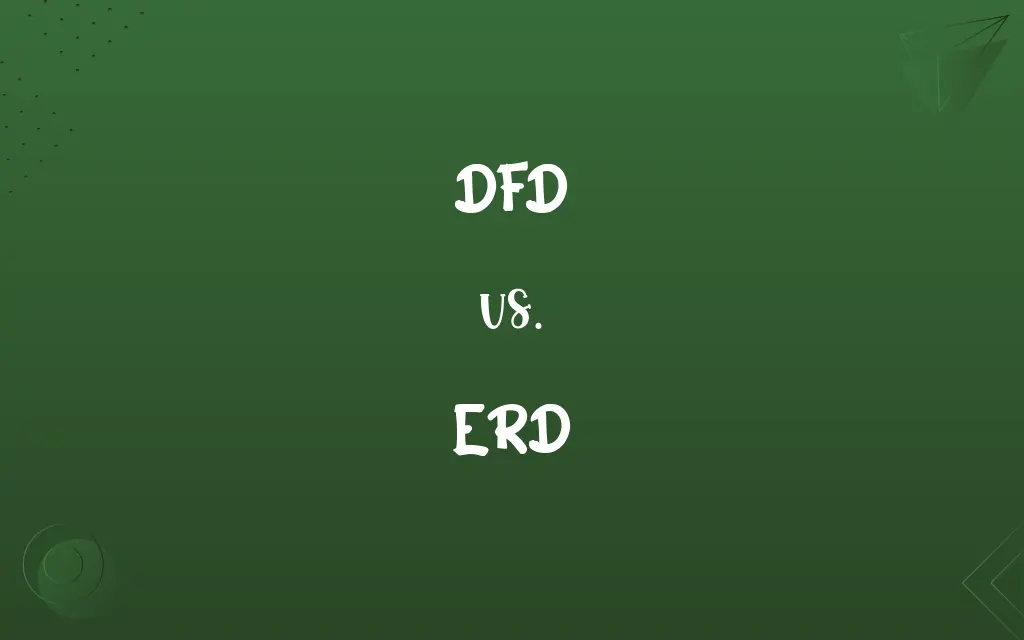DFD vs. ERD: Know the Difference

By Shumaila Saeed || Published on February 26, 2024
DFD (Data Flow Diagram) maps data flow and processes in a system, while ERD (Entity-Relationship Diagram) represents entities and their relationships in a database.

Key Differences
A Data Flow Diagram (DFD) is a graphical representation of the flow of data through a system, depicting how data is processed at various stages. In contrast, an Entity-Relationship Diagram (ERD) focuses on the data's structural framework, highlighting the relationships between different entities in a database. While DFD illustrates how data moves and is transformed, ERD details the data's interconnected structure.
Shumaila Saeed
Feb 26, 2024
DFD is used primarily for analyzing and modeling a system's data processing and flow, often in the initial phases of system design. ERD, on the other hand, is utilized for database modeling, showing how different entities like customers, products, or orders relate to each other in a database. DFD provides a functional view of the system, whereas ERD offers a structural view.
Shumaila Saeed
Feb 26, 2024
In DFD, the main components include processes, data stores, data flows, and external entities. It emphasizes the processes that data undergoes, the sources and destinations of data, and storage points. Conversely, ERD comprises entities, attributes, and relationships, focusing on the types of data stored (entities), their characteristics (attributes), and how they interact (relationships).
Shumaila Saeed
Feb 26, 2024
DFD is process-oriented, making it a key tool in understanding, explaining, and analyzing data pathways and processes in a system. ERD, with its focus on data relationships, is critical in database design, ensuring efficient data organization and retrieval. While DFD maps the journey of data, ERD maps the data's blueprint in a database.
Shumaila Saeed
Feb 26, 2024
In summary, DFD and ERD serve different, yet complementary roles. DFD is instrumental in visualizing and analyzing data flow and processes in systems, vital for system analysts. ERD, in contrast, is indispensable for database designers, providing a clear layout of data entities and their interrelations, crucial for efficient database structure.
Shumaila Saeed
Feb 26, 2024
ADVERTISEMENT
Comparison Chart
Primary Focus
Process and flow of data
Structure and relationships of data entities
Shumaila Saeed
Feb 26, 2024
Main Components
Processes, data stores, data flows, external entities
Entities, attributes, relationships
Shumaila Saeed
Feb 26, 2024
Key Purpose
To visualize how data is processed and flows through a system
To define and organize the data entities and their relationships in a database
Shumaila Saeed
Feb 26, 2024
ADVERTISEMENT
DFD and ERD Definitions
DFD
DFD illustrates the flow of information between various components of a system.
The software engineer created a DFD to demonstrate how user inputs are handled in the application.
Shumaila Saeed
Jan 16, 2024
ERD
ERD is a diagrammatic representation of entities and their relationships in a database.
The ERD for our database clearly outlined the relationship between customers and orders.
Shumaila Saeed
Jan 16, 2024
DFD
DFD is a graphical representation of data flow in a system.
The DFD for the order processing system clearly showed the journey of customer data from order placement to delivery.
Shumaila Saeed
Jan 16, 2024
ERD
ERD is a tool for structuring and visualizing data relationships in database design.
The ERD was instrumental in identifying redundant relationships in our inventory database.
Shumaila Saeed
Jan 16, 2024
DFD
DFD maps how data is processed and transformed in different stages of a system.
Our team used a DFD to analyze the data processing steps in the new inventory management software.
Shumaila Saeed
Jan 16, 2024
ADVERTISEMENT
ERD
ERD depicts entities, their attributes, and the links among them in a database system.
The ERD showed how employee attributes were linked to their respective departments in the company database.
Shumaila Saeed
Jan 16, 2024
DFD
DFD is a tool for understanding the movement and usage of data in system processes.
By examining the DFD, the team could streamline the data flow in the customer service department.
Shumaila Saeed
Jan 16, 2024
ERD
ERD models how different entities in a database are interconnected.
Our database designer used an ERD to illustrate the connections between the product and supplier tables.
Shumaila Saeed
Jan 16, 2024
DFD
DFD identifies sources, destinations, and storage of data within a system.
The DFD helped us identify a bottleneck in data storage during the product ordering process.
Shumaila Saeed
Jan 16, 2024
ERD
ERD helps in understanding the organizational framework of data in a database.
To improve our reporting system, we first analyzed the company's data structure using an ERD.
Shumaila Saeed
Jan 16, 2024
ERD
(zoology) The common European shrew (Sorex vulgaris); the shrewmouse or erd shrew.
Shumaila Saeed
Jan 15, 2024
Repeatedly Asked Queries
What is a DFD?
DFD is a graphical representation showing how data flows and is processed in a system.
Shumaila Saeed
Feb 26, 2024
What are the main components of a DFD?
Processes, data stores, data flows, and external entities.
Shumaila Saeed
Feb 26, 2024
Can DFD and ERD be used together?
Yes, they complement each other in system and database design.
Shumaila Saeed
Feb 26, 2024
Who typically uses DFD?
System analysts and designers for understanding and documenting data processes.
Shumaila Saeed
Feb 26, 2024
How is DFD different from ERD?
DFD focuses on data flow and processes, while ERD focuses on the structure and relationships of database entities.
Shumaila Saeed
Feb 26, 2024
What does an ERD typically include?
Entities, attributes, and the relationships between entities.
Shumaila Saeed
Feb 26, 2024
What is an ERD?
ERD is a diagram that displays the relationships and attributes of entities within a database.
Shumaila Saeed
Feb 26, 2024
Does ERD assist in database normalization?
Yes, ERD is instrumental in organizing data efficiently, aiding in database normalization.
Shumaila Saeed
Feb 26, 2024
Can DFD show data storage?
Yes, DFD includes data stores, indicating where data is stored in a system.
Shumaila Saeed
Feb 26, 2024
Are attributes part of a DFD?
Attributes are not a focus of DFD; they are more relevant in ERD.
Shumaila Saeed
Feb 26, 2024
Can ERD be used for complex database systems?
Yes, ERD is effective for designing and understanding both simple and complex database systems.
Shumaila Saeed
Feb 26, 2024
Who uses ERD?
Database designers and developers for organizing and structuring database elements.
Shumaila Saeed
Feb 26, 2024
Is DFD used in database design?
DFD is more focused on system processes than on database structure.
Shumaila Saeed
Feb 26, 2024
How does DFD help in system design?
It helps by mapping out the data flow and identifying how data is handled at each stage.
Shumaila Saeed
Feb 26, 2024
Is ERD used in system analysis?
ERD is primarily used in database design rather than in overall system analysis.
Shumaila Saeed
Feb 26, 2024
Can DFD help in identifying system bottlenecks?
Yes, DFD can reveal bottlenecks in data processing and flow.
Shumaila Saeed
Feb 26, 2024
What role does ERD play in database management?
ERD is crucial for designing, managing, and maintaining a coherent and efficient database.
Shumaila Saeed
Feb 26, 2024
Is DFD useful for non-technical stakeholders?
Yes, because it provides a straightforward, visual representation of data processes, helpful for understanding by non-technical stakeholders.
Shumaila Saeed
Feb 26, 2024
Is DFD more about data or processes?
DFD is more about processes through which data flows.
Shumaila Saeed
Feb 26, 2024
Does ERD deal with data flow?
ERD does not typically deal with data flow but with data structure and relationships.
Shumaila Saeed
Feb 26, 2024
Share this page
Link for your blog / website
HTML
Link to share via messenger
About Author
Written by
Shumaila SaeedShumaila Saeed, an expert content creator with 6 years of experience, specializes in distilling complex topics into easily digestible comparisons, shining a light on the nuances that both inform and educate readers with clarity and accuracy.









































































